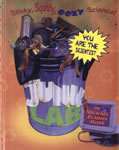Solve Problems and Draw Conclusions
Shift the focus from finding one answer to exploring multiple perspectives and options. Identify problems and solutions.
- Example. If a BLANK met a BLANK, what might happen?
Science Interactives and Nonfiction Reading
Use web-based interactives that require reading nonfiction to solve problems:
- Standards
- Science Standard 3.1.4. Discuss the results of investigations and consider the explanations of others.
- Science Standard 4.2.6. Support statements with facts found in print and electronic media, identify the sources used, and expect others to do the same.
- Science
Nonfiction Reading and Scientific Method
 Standards
Standards
- English Standard 3.2.6. Locate appropriate and significant information from the text, including problems and solutions. (Core Standard)
- English Standard 4.2.4. Evaluate new information and hypotheses (statements of theories or assumptions) by testing them against known information and ideas.
- Science Standard 6.2.5. Organize information in simple tables and graphs and identify relationships they reveal. Use tables and graphs as examples of evidence for explanations when writing essays or writing about lab work, fieldwork, etc.
- Activity
- Explore science experiments.
- Design your own experiment using the scientific method.
- Conduct your own experiment.
- Resources
- Indoor Zoo (Google Limited Preview) by Michael Elsohn Ross, Tim Seeley
- Junk Lab (Google Limited Preview) by Linda Lowery, Michael Elsohn Ross, Betty Botts
- Kitchen Lab (Google Limited Preview) by Michael Elsohn Ross, Tim Seeley
- Toy Lab (Google Limited Preview) by Michael Elsohn Ross, Tim Seeley - Read about the scientific method. Then, design your own experiment.
Reasoning and Nonfiction Reading
- Standards
- English Standard 6.2.7. Make reasonable statements and conclusions about a text, supporting them with evidence from the text. (Core Standard)
- English Standard 7.2.7. Draw conclusions and make reasonable statements about a text, supporting the conclusions and statements with evidence from the text. (Core Standard)
- Activity
- Go to The Quest for the Perfect Tomato. Read the two comics. Then respond to the question: Do you think these genetically modified food are a good idea? Share your reasoning in the form of a cartoon.
- Use Make Beliefs Comix
Problems and Solutions
- Standards
- English Standard 8.2.5. Use information from a variety of consumer and public documents to explain a situation or decision and to solve a problem.
- English Standard 8.2.9. Make reasonable statements and draw conclusions about a text, supporting them with accurate examples. (Core Standard)
- English Standard 8.2.2. Analyze text that uses proposition (statement of argument) and support patterns. (Core Standard)
- Activity
- Go to It's Not Waste Until You Waste It. What are the problems related to waste? What can you do to address the problem in your personal life?
Focus on Inference
Inference. Students make inferences when they are able to draw conclusions and make predictions about something implied by not stated explicitly. Students are successful when the bits and pieces they've read become part of a "big picture" that they are able to share.
Think about the types of inferences that students will be learning (Johnson & Johnson, 1986).
- Location. "After feeding the penguins, Dr. Franklin decided it was time to clean the lion's cage." Where are we?
- Agent. "Sam picked up the hose and directed it toward the fire." What is Sam's job?
- Time. "Juan rubbed his eyes, yawned, and jumped out of bed." When did this occur?
- Action. "Kelly grabbed the bat and walked toward the plate." What is Kelly doing?
- Instrument. "Susan took her bowl of soup to the table, but she forgot her utensil." What did Susan forget?
- Category. " The beagle and poodle were sleeping but the sheep dog was barking." These three are members of what group?
- Object. "The gentle giant's trunk sprayed water across it's rough grey back." What is the "gentle giant"?
- Cause-Effect. "When Ben wore up from his nap on the lawn chair, his skin was bright red." What caused Ben to turn red?
- Problem-Solution. "Mandy's stomach rumbled." What should Mandy do?
- Feelings-Attitudes. "As Emily approached the empty lot where she loved to play she noticed the trees had been cut down, and her eyed filled with tears." What was Emily feeling?
- Standard
- English Standard 5.2.4. Draw inferences, conclusions, or generalizations about text and support them with textual evidence and prior knowledge. (Core Standard)
- Activity
- Go to Fighting Dinos. Explore the dinosaur evidence. What do you think is the most convincing evidence? Why?
- Go to Energy. Explore issues in energy production and conservation. What do you think should be done to solve the world's energy problems? Why?
For more ideas related to Reading and Inference, go to my workshop: Inferential Thinking Across the Curriculum.

